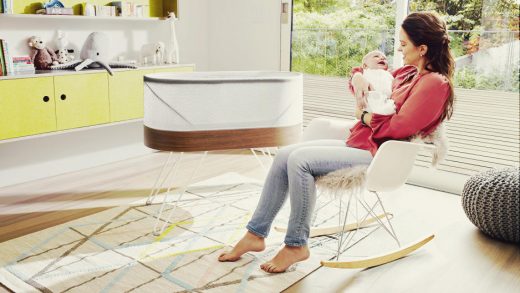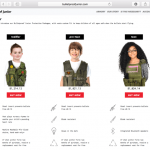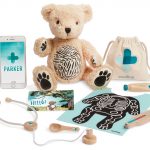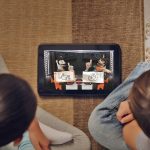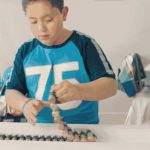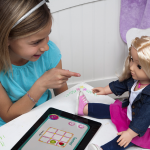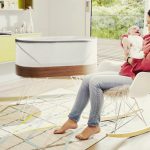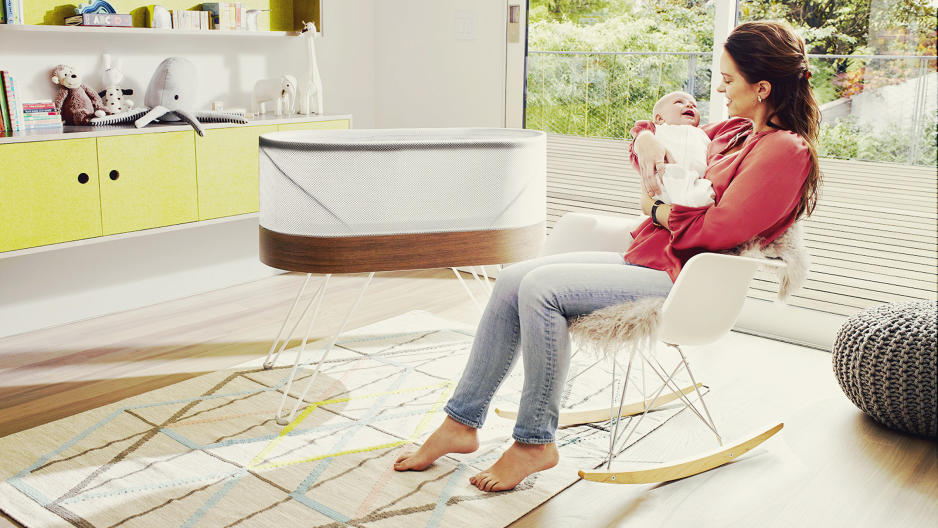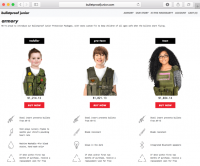The SNOO Baby Sleeper: The Best Crib Most Parents Can Only Dream About
Impulsiveness. Moodiness. Headaches. The side effects of getting too little sleep can feel a bit like a hangover—or being tipsy, but without the fun and social part. Parents experience a lot of joy, but the first three to six months of raising a newborn can also be a marathon of sleep deprivation on par with Navy SEAL training. Getting just 15 minutes more sleep can sometimes be a life saver, literally. Because exhausted parents make stupid mistakes.
The pediatrician Dr. Harvey Karp, author of the best-selling book The Happiest Baby on the Block, calls it “drunk parenting.” The statistics back him up: Of the 3,500 sudden unexpected infant deaths tracked by the Centers for Disease Control each year, 875 are due to accidental suffocation in bed. Many of those are the result of exhausted parents who bring infants into their own bed, or worse, fall asleep next to them on the couch. That’s why Karp and his wife, Nina Montée Karp, set out to create the safest, most advanced baby sleeper ever invented, the SNOO.
It’s not the only reason: SNOO, which was released in October, is a smart baby bed, part of the emerging universe of connected devices for your home. But it’s more accurate to call it a robot, because the SNOO attempts to replicate the soothing sound and motion of a parent or nanny, gently rocking babies through a series of jiggling motions and shushing noises until they fall asleep.
“At times it could feel a little like I was outsourcing my parenting to technology,” says Kate Davis, a Fast Company senior editor who tested the bed with her newborn baby, Ben, for a few weeks this fall. But it also allowed her, at times, to stay in bed a bit longer.
A desperately bleary-eyed parent will pay almost anything for a few more winks. SNOO is not cheap: It sells for $1,160. There are more expensive baby beds—a custom crib can set you back $3,000 or more—but there are also plenty of perfectly safe options available in the $300 and under range, too.
To fully understand the SNOO, you have to know a bit about Dr. Karp’s thesis on babyhood. “The concept is that babies are born three months before they’re ready for the world,” he says. A mother gives birth when she does in part because the baby won’t be able to get out if the head gets any larger. And in Karp’s view, that means a baby’s so-called fourth trimester should be spent replicating the experience inside the womb as much as possible.
One way to do that is by wrapping your baby up in a blanket, snug as a bug in a rug. When The Happiest Baby came out in 2002 and recommended that parents swaddle their newborns, it was an instant trend. Well into the 1800s, swaddling was a widespread practice until doctors came to believe it was harmful to children because it straitjacketed their mobility. And around that same time, fussy babies were being treated with opium and alcohol concoctions—Stickney and Poor’s Pure Paregoric syrup was a popular brand. And that remained a an option for pediatricians all the way until gen-Xers were born.
“When I was training at Albert Einstein [College of Medicine] in the Bronx in the 1970s, I was taught how to prescribe opium for babies,” says Karp. Now, of course, your doctor could be put in jail for doing such a thing.
But swaddling is back in a big way. Today you can buy swaddle blankets in all colors and styles; some even have velcro so that you don’t have to learn how to fold. Despite being responsible for this resurgence, Karp has never released a swaddle blanket of his own, until now. The SNOO sleep sack, or “five-second swaddle,” which is included in the package and comes in three sizes, is a more breathable and easier-to-use variation on the original theme. Inside the sack, a velcro strap goes across the baby’s chest to keep the arms down. The sack then zips up to the baby’s chin, and there are mesh openings across the middle and bottom to let air flow through. There’s also a zipper on the bottom in case you need to change a diaper.
The most important part of this swaddle is that it has two “wings” that come off the side of the swaddle and have loops on the end. Those loops attach into hooks on the inside of the bassinet, ensuring your baby can’t roll over. The SNOO will not work unless these straps are in place. “And it’s actually because of this, in large part because of this, that this is the safest baby crib that’s ever been created,” says Karp. “Because we’ve never in the history of parenting had the opportunity to know that babies are going to stay in that same position all night long.”
With the baby safely strapped to the bassinet, the real magic begins. Before I explain it in detail, just watch this video showing infants falling asleep inside the SNOO.
When you first put a baby into the SNOO and turn it on, either via a button on one end or using the mobile app, it starts to jiggle while making a low shooshing noise. There are four different levels of sound and motion, each lasting about six minutes. Karp says the motion is probably like what a baby feels in the womb when mom goes up and down stairs.The sound, which comes from a small speaker under the mattress, is similar to rain on a rooftop, but set at a lower pitch.
The SNOO glides through each level, down, down, down, until the child is asleep. Anyone who has dozed off during a plane takeoff, a train ride, or a long road trip can appreciate why this is an effective technique for putting a child to bed.
Three microphones around the rim of the sleeper listen to the baby so that when she wakes or cries out, SNOO will increase the amount of motion and volume of the white noise in order to lull her back to sleep. If the baby makes noise for three minutes, SNOO automatically shuts itself off—it knows that the baby needs more than it can provide. Other than that, it moves continuously all night long.
Baby In Motion
This constant motion was the first concern for Davis during her test of the SNOO. Don’t babies become habituated to the motion and noise, thus making it difficult for them to sleep in a crib that doesn’t move and make noise later on? Karp says it will be no harder than breaking a baby of other habits, such as using a pacifier or a dangling musical mobile.
The bigger problem is that the bed’s sound sensors were far too noise sensitive, at least in Davis’s small New York apartment. “A short list of things it reacted to: my hair dryer coming from the next room, pots and pans in the kitchen, the cat meowing, my husband and I talking,” Davis says. “It would also react to some of Ben’s fussing (and certainly his crying), but not all of his fussing.” She thought that pairing the sound with a motion sensor would improve the accuracy. Or perhaps just having a bigger house would have solved things. (Update: Dr. Karp says the sound responsiveness of the SNOO has been improved since the version Fast Company tested.)
Still, the SNOO is something of a technological marvel. It took five years to create, and pairs MIT Media Lab-trained engineers with design by Yves Béhar. The real breakthrough is the internal motor. A retired automobile engineer helped the team devise a brushless gimbal that allows the crib to change speed as well as amplitude smoothly and without any gears—a set of rubber O rings run back and forth on a track instead. This was difficult to pull off, and had to be perfect—the tiniest squeak or chunking of a gear would ruin the entire purpose of this device.
And it had to stand more hours of wear and tear than your average baby swing. Those work great but are only made to run for about an hour a day, and go back and forth maybe 200,000 times. The SNOO is meant to be used 14 hours a day for six months, and is built to run for at least 2 million cycles. “And actually, our testing stops at 15 million cycles,” says Karp. “Which should be enough for two or three babies.”
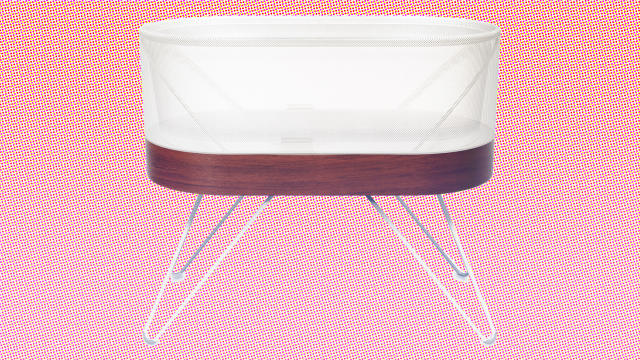
The Quantified Infant
Since the primary purpose of the SNOO is to rock your baby to sleep, it’s fair to wonder why it needs to have a Wi-Fi connection (which is hidden inside the foot of the crib under a shield that will prevent any potentially harmful radiation). As with most devices in the Internet of Things (IoT) world, this allows the crib’s inner workings to be updated remotely over time. It can be used to fix minor problems or add new features. But mostly it’s so that the mobile app can connect to the crib from another room.
The app was initially going to be much fancier, says Karp. In 2010, when his team members began to work on the sleeper, the quantified self was the tech trendlet of the moment. They were going to include a bunch of analytic data points about the baby, primarily to measure sleep. But over time they realized that the data was kind of pointless. The SNOO itself did the thing that so many IoT products fail to do, which is use data and feedback to provide an actual solution. So the app was simplified to be a fancy remote control that lets a parent stay in bed while adjusting the activity level of a crib that might be in another room.
“The best aspects are that it helped him fall back to sleep when he’d wake up from gas,” says Davis of her experience testing the crib with Ben. “And when all else was failing to put him to sleep, I knew I could put him in it, and it would—I’d say 80% of the time—make him fall asleep.”
The SNOO isn’t a magic solution to your sleepless nights, and shouldn’t be expected to transform your baby. But it’s a useful tool—if you can afford it—that makes new parenthood a little easier and safer.
Correction: Engineering work on SNOO was done by MIT’s Media Lab, rather than MIT. And there is a weaning feature in the mobile app to help with the transition to a crib that was overlooked. The story has been updated to reflect these changes.
Fast Company , Read Full Story
(101)

